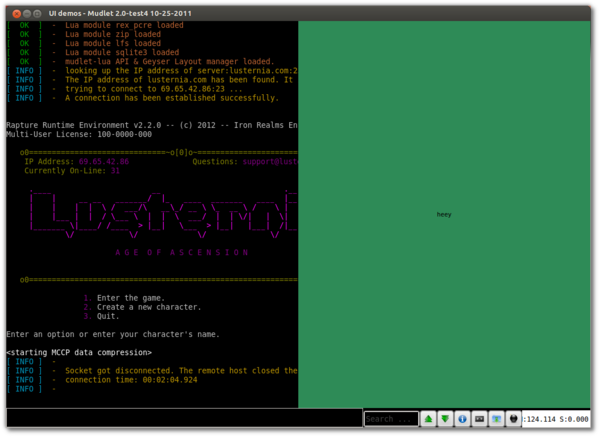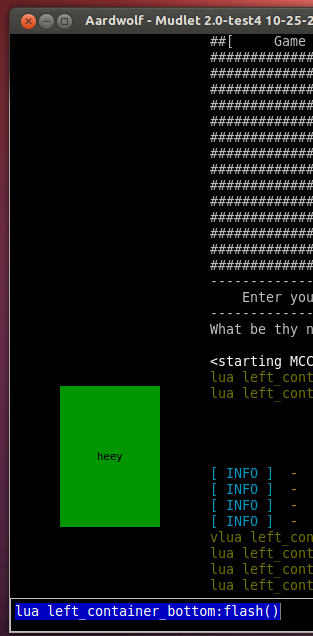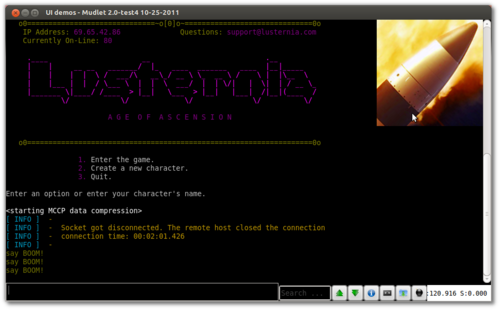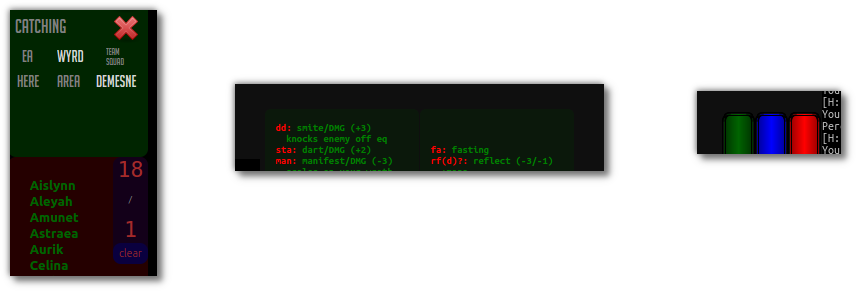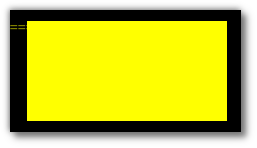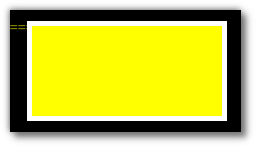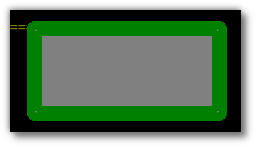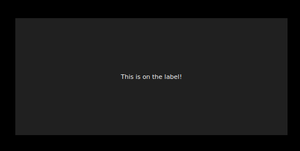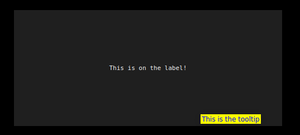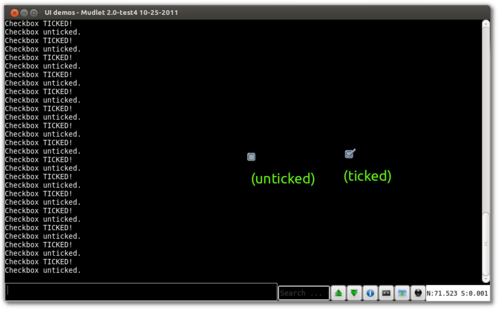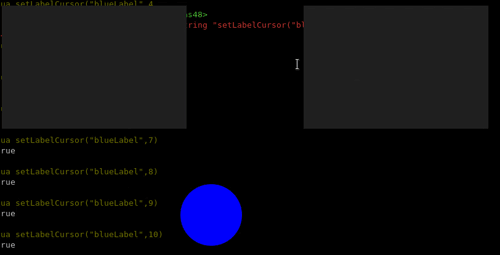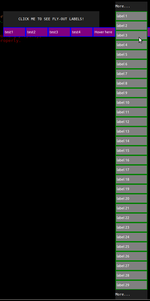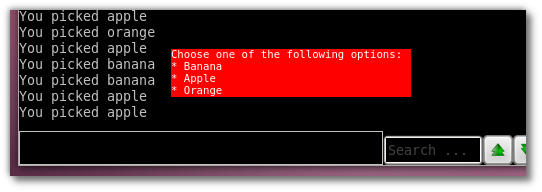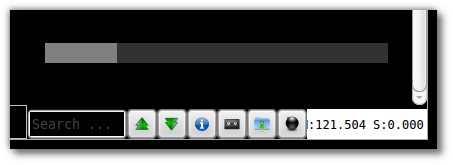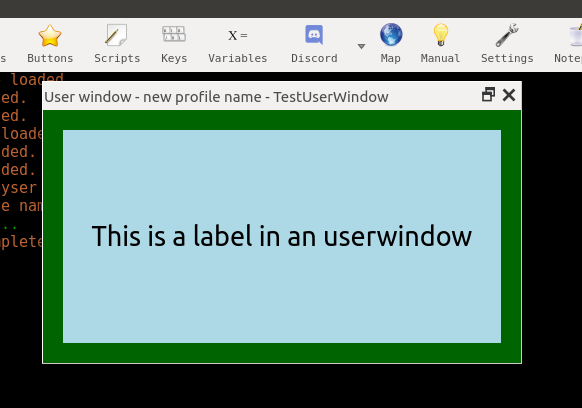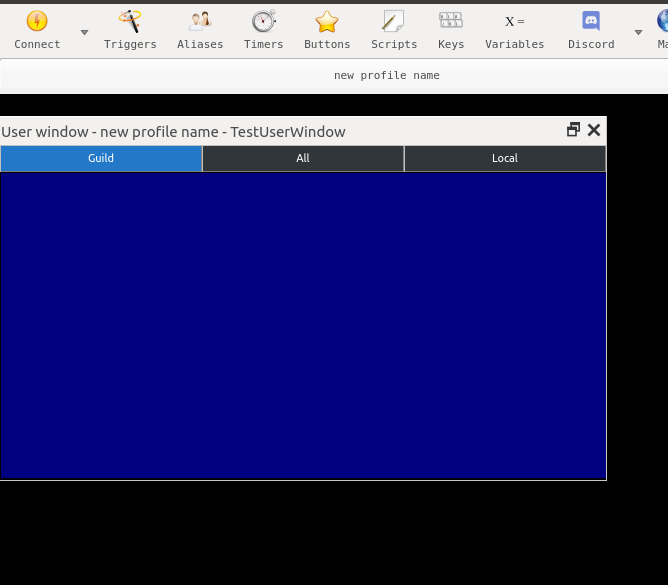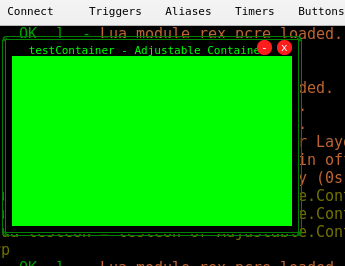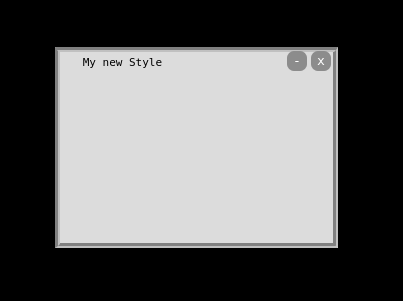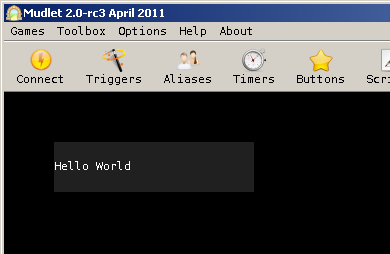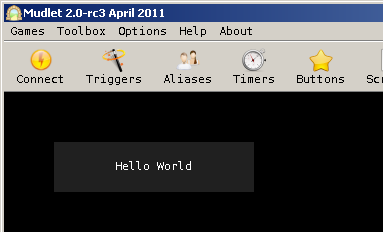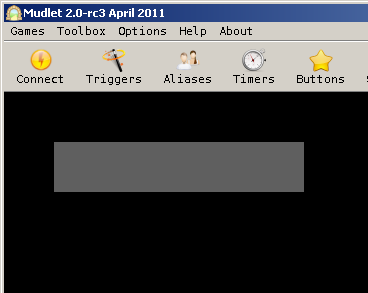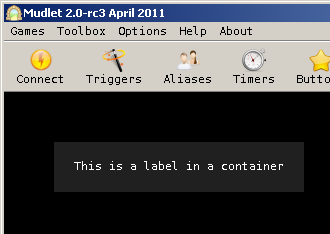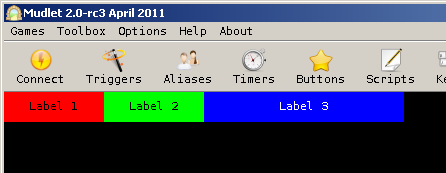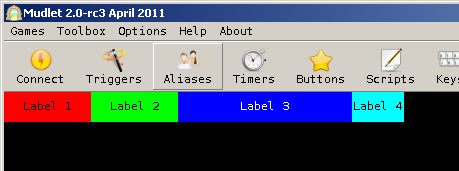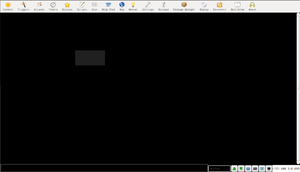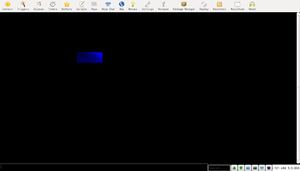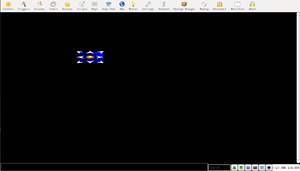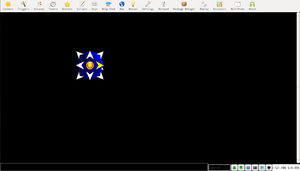Manual:Geyser
Introduction
The Geyser Layout Manager is an object oriented framework for creating, updating and organizing GUI elements within Mudlet - it allows you to make your UI easier on Mudlet, and makes it easier for the UI to be compatible with different screen sizes.
Motivation
Mudlet makes the creation of label, miniconsoles and gauges a quick and easy thing. Mudlet provides a nice signal when window resize events happen. To help with complex window management, Geyser steps in.
Main Geyser Features
Geyser is based on traditional GUI concepts and should feel similar to using Java's Swing. The biggest difference is in how positions are specified.
- All window positions are specified relative to their container - nothing new there. However, window positions can also take on percentages and negative pixel and character values. For instance, a window could be constrained to have a height of 50% of its container and a width such that the window's right edge is always 20 characters from its container's right edge. See examples below and the demos/tests that come with Geyser.
- All windows under Geyser control are automatically resized as necessary when the main Mudlet window is resized. Once you create a window and assign it to a container, you never have to worry about positioning it again. Nonetheless, it's very easy to shift the container that a window is in, maintaining its constraints so that it resizes as needed according to the dimensions of the new container.
- Due to the container hierarchy, hiding a container window automatically hides all its contained windows too. The same for show. With clever construction and labels with callbacks, this lets one make complex GUI elements that are minimizable or maximizable or ...
- However, there is always some overhead for automation systems and Geyser is no exception. Fortunately, most of the overhead is during window creation and resize events - not things that happen frequently.
Getting pictures for your stuff
You can find good, freely-available assets for your UI here:
Constraints format
Geyser position constraints are a string composed of a number and a format type. For example, "10px" means 10 pixels, either pixels from the origin (e.g. x or y) or a value for the width or height. A negative number indicates distance from a container's right or bottom border depending on whether is a constraint for x/width or y/height, respectively. Percentages for width and height are in terms of the container's dimensions and negative values are converted to the equivalent positive value. A 100% width subwindow with an x-coordinate of 10 will have part of itself displayed outside the confines of its container. There is no hard limit on maximum window size, just as with regular Mudlet windows. If a number, n, is passed as a constraint instead of a string, it is assumed to be equivalent to "npx". Any Lua table that contains entries for x, y, width and height in the proper format can be used for Geyser constructors and setting constraints. Just like in Mudlet, 0,0 coordinates mean the top-left corner.
The following is a valid example for coordinates of a Geyser object:
{x = "20px", y = "-10c", width = "40%", height = 30}Geyser elements
The purpose of this document is to go through every Geyser element and provide practical examples on how they are used. Read it from top to bottom, preferably doing all of the examples to understand how they work!
See also: https://www.mudlet.org/geyser/files/index.html for a brief and technical overview of all elements and their functions.
Geyser.Container
An invisible, organizing object in Geyser - use it to divide your screen and position elements accordingly. See here for all of the functions that are available to you to use.
A container is also the base class - which means that everything (labels, miniconsoles and gauges) can use its functions, since everything else is at heart a container.
Creating a container
To get started with a container, here's an example that'll create a 200px border on the left side of Mudlet for you, and make a container cover all of it - so you can place other visual elements inside it:
setBorderLeft(200)
left_container = Geyser.Container:new({
name = "left_container", -- give it a unique name here
x=0, y=0, -- have it start at the top-left corner of mudlet
width = 200, height="100%", -- with a width of 200, and a height of the full screen, hence 100%
})Right away, you'll see space appear on the left side. It'll be black, as the container is an invisible unit by itself. You can make sure it's there by making it flash by doing this from the input line:
lua left_container:flash()The command will cause your container to flash for a moment for you, revealing itself.
Container within a container
You can place containers within other containers by specifying which "parent" the new container should have when you create one. Given our previous example, you can split the left side into two halves like this:
left_container_top = Geyser.Container:new({
name = "left_container_top",
x=0, y=0, -- this container occupies the top, so it starts top-left as well
width = "100%", height="50%", -- but only uses up half of the height
}, left_container) -- this is the important bit - it says that left_container_top should be inside left_container
left_container_bottom = Geyser.Container:new({
name = "left_container_bottom",
x=0, y="50%", -- this container starts halfway down the first one
width = "100%", height="50%", -- and has the same half height of the original container
}, left_container)Aligning relative to bottom or right sides
The aligning point within Mudlet is the top-left corner, and it's the same for the elements they are aligned - the position you specify is used by the top-left corner of the element.
Using Geyser, you can align to the opposite side as well, using the coordinates in negatives, while keeping the dimensions of the object in mind. For example, if you want to align a box that's 20px wide on the usual left side, you'd give it a width of 20 and an x value of 0. If you'd like to align it on the right side, then you'd give it an x value of -20. The box will spawn 20px away from the right side and "grow" to the right by 20px.
right_container = Geyser.Container:new({
name = "right_container",
x="-20%", y=0, -- makes the container start 20% of the screen away from the right side
width = "20%", height="50%", -- filling it up until the end
})Do make sure to account for the scrollbar, as Mudlet UI elements can overlap it. You can also move the scrollbar with setBorderRight().
Geyser.Label
Based on the Mudlet label, this allows you to use the labels functionality within Geyser. Labels allow you to use pictures in your interface, as well as nicely-formatted text.
Basic label
Here's an example to get you started with:
testlabel = Geyser.Label:new({
name = "testlabel",
x = "50%", y = 0,
width = "50%", height = "100%",
fgColor = "black",
color = "SeaGreen",
message = [[<center>heey</center>]]
})This labels x coordinate is specified as 50% - and because it's not attached to any container, this implies that the window will start halfway at the main window. You can tell it's not attached to a container because there's nothing in between the last } and ), the place where the container goes.
The y coordinate is 0 - which means that the label will start at the top of the screen. With the width being 50%, the label will occupy 50% of the screen - and since it starts at the halfway point, it means it'll occupy the entire right side. A height of 100% means that it'll stretch from the top to the full bottom.
Here's what that'll look like:
Playing around with the starting location and dimensions, we can also place it in the center of the screen with:
testlabel = Geyser.Label:new({
name = "testlabel",
x = "25%", y = "25%",
width = "50%", height = "50%",
fgColor = "black",
message = [[<center>heey</center>]]
})
testlabel:setColor(0,255,0,150)To change the message on a label, you can use the mylabel:echo() function, where mylabel is the name of the label you gave it:
mylabel:echo("hello!")Setting the font size
To set a different font size for your Label, use the setFontSize() method. For example:
testlabel:setFontSize(14)The font size is set in Pt, so anything above 30 will likely be too large to be useful.
Label inside a container
Once you've got your containers and mastered the basic labels, you can drop labels into your nicely-organized containers. Doing so is similar to nesting containers:
testlabel = Geyser.Label:new({
name = "testlabel",
x = "25%", y = "25%",
width = "50%", height = "50%",
fgColor = "black",
message = [[<center>heey</center>]]
}, left_container_bottom) -- this is where we tell it what container to go into
testlabel:setColor(0,255,0,150)That label is exactly the same as the one above that goes across the screen, except it's in our bottom-left container - so it looks appropriately different:
Image on a label
One of the more amazing things labels allow you to do is put pictures anywhere on your Mudlet screen, that blend in very well. To do so, once the label is created, use the setBackgroundImage() function with the exact path to the image (![]() ):
):
picture_label = Geyser.Label:new({
name = "picture_label",
x = 0, y = "-14px",
width = "16px", height = "14px",
})
picture_label:setBackgroundImage([[/home/vadi/Desktop/skullface.png]]) -- update location to actual image location on your computerThis'll plop the picture to the bottom-left of your screen. To make the picture show, download the skullface picture above - save it to your desktop, and adjust the location of the image within [[]]'s to what it is on your computer. For example, if you saved this on your Windows 7 desktop, it would be:
picture_label:setBackgroundImage([[C:/Users/<your user name>/Desktop/skullface.png]])(yes, that's / and not \ - \ has been known not to work)
If you saved this on your Mac desktop, it would be:
picture_label:setBackgroundImage([[/Users/<your user name>/Desktop/skullface.png]])If you saved this on your Ubuntu desktop, it would be:
picture_label:setBackgroundImage([[/home/<your user name>/Desktop/skullface.png]])Using this basic building block, you can work up to making yourself a UI!
Stretching an image on a label
If you'd like your image not to keep it's original size, but instead use up the available space of the label - you can use the border-image stylesheet property to do so.
label = Geyser.Label:new({
name = "label",
x = "50%", y = "50%",
width = "50%", height = "50%",
})
-- change the location to your picture
-- on windows, use / to separate folders still, not \
label:setStyleSheet[[
border-image: url(/home/vadi/Desktop/iso-avatar-draft_0.png);
]]![]() Note: If you're on a Mudlet earlier than 3.15 and are having difficulty with the image coming up, it may be because of strange differences between Qt's CSS engine which does not affect mudlet's Lua. You may want to try appending :gsub("\\","/") to your string including getMudletHomeDir() (e.g.
Note: If you're on a Mudlet earlier than 3.15 and are having difficulty with the image coming up, it may be because of strange differences between Qt's CSS engine which does not affect mudlet's Lua. You may want to try appending :gsub("\\","/") to your string including getMudletHomeDir() (e.g. getMudletHomeDir():gsub("\\","/")). No longer necessary after Mudlet 3.15.
Aligning an image within a label
You can use background-image in combination with background-position to align an image within a label (if, say, the image is much smaller than the label).
-- this will set and align an image top-right of the label
if stunning then
mylabel:setStyleSheet([[
background-image: url("/home/vadi/Games/Mudlet/Offensive/Artwork/dialog-ok.png");
background-repeat: no-repeat; background-position: top right; background-origin: margin;
]])
else
mylabel:setStyleSheet([[
background-image: url("/home/vadi/Games/Mudlet/Offensive/Artwork/dialog-no.png");
background-repeat: no-repeat; background-position: top right; background-origin: margin;
]])
endShowing / hiding a label
You can show and hide labels, as you can any container, miniconsole or a gauge in Geyser with Geyser.Container:show() and Geyser.Container:hide(). Remember that since labels are a type of a container, all container functions work on them.
Hiding a label will allow you to click through on what is below the label, as well as free up the visual space for something else.
testlabel = Geyser.Label:new({
name = "testlabel",
x = "50%", y = 0,
width = "50%", height = "100%",
fgColor = "black",
color = "SeaGreen",
message = [[<center>heey</center>]]
})
-- hide the label with:
testlabel:hide()
-- show the label with:
testlabel:show()Clickable images
Tacking onto the fact that you can plop images anywhere on your Mudlet screen now, you can also make them react to your clicks. You can do so with the setClickCallback() function - by giving it a function to call when your label is clicked, you'll make it react.
picture_label = Geyser.Label:new({
name = "picture_label",
x = "-215px", y = "0px",
width = "200px", height = "200px",
})
picture_label:setBackgroundImage([[/home/vadi/Desktop/qubodup-opengameart-cc0-200px-missile_icon.png]]) -- update location to actual image location on your computer
picture_label:setClickCallback("on_bomb_press")
function on_bomb_press()
send("say BOOM!")
endThat's it! Pressing on the image will make the on_bomb_press() function go off, which will do its code of send("say BOOM!"). Download the picture for use here.
Styling labels
Besides putting text or images on labels, you can also style them using Qt's stylesheets feature. Doing so allows you to create various graphics that make the label look more appealing:
To set a stylesheet on a label, use the Geyser.Label:setStyleSheet() function on your label, describing the stylesheet you'd like to give it. A stylesheet consists of properties you set - for example the background color, borders, padding, and so forth. You describe properties in the following format: property name:values;. See here for a list of all supported properties. For example, to make your labels background be yellow, you'd use the background-color property:
mylabel = Geyser.Label:new({
x = "50%", y = "50%",
width = 200, height = 100
})
mylabel:setStyleSheet([[
background-color: yellow;
]])Which is nice, but not particularly impressive.
Scrolling down the list of properties, you'll come along a border one. Plopping it into our stylesheet nets the following:
mylabel:setStyleSheet([[
background-color: yellow;
border: 5px solid white;
]])Which gives a border!
Fiddling with it some more and applying new properties we find on that page, we get a rounded border on our label:
mylabel:setStyleSheet([[
background-color: grey;
border-width: 15px;
border-style: solid;
border-color: green;
border-radius: 10px;
]])Which'll conclude our exploration for now. Try out all of the other possible options available there - there's loads, from funky borders, to tiling images and fancy color combinations using gradients.
Adding a tooltip to a label
Since Mudlet 4.6, you can now add a tooltip to labels and gauges. You can start by making a simple label and echoing some text to it:
testLabel = Geyser.Label:new({
name = "testLabel",
x = "50%",
y = "50%",
height = "25%",
width = "25%",
})
testLabel:echo("This is on the label!")
testLabel:setAlignment("center")
-- sets the tooltip text
testLabel:setToolTip("This is the tooltip", "10")
-- optionally - you can customise the tooltip, too!
testLabel:setStyleSheet("QToolTip{background: yellow; color: blue; border:none;}")Without tooltip
With tooltip
Avoid stylesheet inheritance by tooltip
![]() Note: If you set a new stylesheet for a label and with that a background image it is possible that through inheritance the tooltip also has this stylesheet image.
Note: If you set a new stylesheet for a label and with that a background image it is possible that through inheritance the tooltip also has this stylesheet image.
To avoid this specify that the stylesheet is meant for the Label by using QLabel{...} in your Label stylesheet for exampleː
label = Geyser.Label:new({
name = "label",
x = "50%", y = "50%",
width = "50%", height = "50%",
})
-- by using QLabel{...} the stylesheet won't be given to the tooltip as well
label:setStyleSheet[[
QLabel{
border-image: url(/home/vadi/Desktop/iso-avatar-draft_0.png);}
]]
Aligning text/images inside a label
By default, text is centered vertically and left aligned in a label. To align it to a specific side, use the stylesheets we learnt about earlier with the qproperty-alignment:
mylabel = Geyser.Label:new({
name = "testlabel",
x = "50%", y = 0,
width = "50%", height = "100%",
fgColor = "black",
color = "SeaGreen",
message = [[<center>heey</center>]]
})
-- specify one property this way:
mylabel:setStyleSheet([[qproperty-alignment: 'AlignTop';]])
-- or multiple ones separated with a |, for example this will align text to top-left:
-- specify one property this way:
mylabel:setStyleSheet([[
qproperty-alignment: 'AlignLeft | AlignTop';
]])
mylabel:echo("hi!")Enabling wordwrap in a label
If you need to enable word wrapping in a label (which by default is off), add the following line to the labels stylesheet:
qproperty-wordWrap: true;
As an example:
mylabel:setStyleSheet([[
qproperty-wordWrap: true;
]])If you'd like to set multiple properties, set them all at once - not via multiple :setStyleSheet() calls:
mylabel:setStyleSheet([[
background: red;
]])Adding a hover effect to a label
The labels support adding stylesheets for specific cases, such as when a mouse is hovering over them. To make this work, you provide CSS for when the label is in its usual state, and for when it is hovered over:
-- this example will add a border to the label when it is hovered over
mylabell:setStyleSheet([[
QLabel{ border-radius: 4px; }
QLabel::hover{
background-color: rgba(0,0,0,0%);
border: 4px double green;
border-radius: 4px;
}
]])Checkboxes
Combining the fact that you can click on a label with an image to do something with the fact that you can change pictures on a label at will, you can make an image that changes itself when you click on it.
picture_label = Geyser.Label:new({
name = "picture_label",
x = "50%", y = "50%",
width = "21px", height = "19px"
})
-- a little trick we do to make the background of the label be transparent
picture_label:setStyleSheet([[
background-color: rgba(0,0,0,0%);
]])
picture_label:setBackgroundImage([[/home/vadi/Desktop/checkbox_ticked.png]])
picture_label:setClickCallback("on_checkbox_press")
function on_checkbox_press()
if checkbox_ticked then
checkbox_ticked = false
picture_label:setBackgroundImage([[/home/vadi/Desktop/checkbox_unticked.png]])
echo("Checkbox unticked.\n")
else
checkbox_ticked = true
picture_label:setBackgroundImage([[/home/vadi/Desktop/checkbox_ticked.png]])
echo("Checkbox TICKED!\n")
end
endThe on_checkbox_press() function this time keeps the track of the checkbox with the checkbox_ticked variable and sets the image appropriately. You can download the ticked (![]() ) and unticked images (
) and unticked images (![]() ) or the whole package altogether.
) or the whole package altogether.
Animated labels
Using timers and several pictures, you can make your labels change quickly enough and look animated. Here's one such example:
picture_label = Geyser.Label:new({
name = "picture_label",
x = 10, y = "-24px",
width = "16px", height = "14px",
})
santa_counter = nil
function animate_santa()
santa_counter = (santa_counter or 0) + 1
if santa_counter > 8 then santa_counter = 1 end
picture_label:setBackgroundImage([[/home/vadi/Desktop/santa/santa]]..santa_counter..[[.png]]) -- update location to actual image location on your computer
santa_timer = tempTimer(.16, animate_santa)
end
animate_santa()The completed package is available here, install it and do start/end animation to watch.
Inserting extra spaces and newlines
Echoing text into Mudlet and Geyser labels is different from miniconsoles and the main window, due to their nature. One of the differences is that extra spaces in a label, by default, get compressed down to one. To add extra spaces in a label, replace extra spaces with or by wrapping your text with them inside <pre>my text here</pre>.
-- this won't work, it'll show as one space:
mylabel:echo("You -> point")
-- but this would, because it replaces all spaces with   before echoing
mylabel:echo(string.gsub("You -> point", " ", " "))-- here is another way to go about this - and it additionally makes the font be monospaced:
mylabel:echo("<pre>You -> point</pre>")To add a new line in a label (aka linebreak), use
(instead of \n as you are used to in an echo).
mylabel:echo("These<br>words<br>are<br>split")Transparent labels
One of the possible ways of achieving transparency on a label is to add background-color: rgba(0,0,0,0%); to its stylesheet. Here's an example:
my_transparent_label:setStyleSheet([[
background-color: rgba(0,0,0,0%);
]])Custom mouse cursor
You can change the shape of the cursor when it's over your label with:
mylabel:setCursor("Forbidden") -- will change your mouse cursor to "forbidden" (as in "can't do this") cursorPossible cursor shapes are available here, and you can import this demo package to try them all out.
It is also possible to change the mouse cursor to a custom made cursor by:
mylabel:setCustomCursor(getMudletHomeDir().."/custom_cursor.png")It is recommended that the custom cursor is a png with size of 32x32 to be supported on all systems.
![]() Note: Available in Mudlet 4.8+
Note: Available in Mudlet 4.8+
Flyout Labels
Flyout labels allow you to create 'dropdown' or 'flyout' menus - menus that reveal more items once you hover your mouse over them. To create flyout labels:
- add
nestable=true(left click to open menu) ornestflyout=true(mouse hover to open menu) to your main label. - use :addChild() on your main label to add flyout labels to it.
- :addChild() uses the same arguments as when creating a new label but also takes the layoutDir option to specify in which direction and axis should the labels align, where 2 letters combine into the option: first letter R for right, L for left, T for top, B for bottom, followed by the orientation: V for vertical or H for horizontal. So options are:
layoutDir="RV",layoutDir="RH",layoutDir="LV",layoutDir="LH", and so on.
- :addChild() uses the same arguments as when creating a new label but also takes the layoutDir option to specify in which direction and axis should the labels align, where 2 letters combine into the option: first letter R for right, L for left, T for top, B for bottom, followed by the orientation: V for vertical or H for horizontal. So options are:
- optionally, add
flyOut=trueto your flyout labels to make the labels dissapear when the mouse isn't hovering over them anymore.
Note that the main flyout label cannot go into a container and needs to be on its own.
![]() Note: Requires Mudlet 3.0.
Note: Requires Mudlet 3.0.
Demo
Here's an example that follows the steps above:
label0 = Geyser.Label:new({name="label0",
x="50%",y="50%",height=50,width=300,nestable=true,
message="<center>Clicky clicky</center>"})
-- and add 3 labels to it with RV layout - so Right of the label, aligned Vertically
label1 = label0:addChild({name="label1",height=30,width=70, layoutDir="RV", flyOut=true, message="label one"})
label1:setStyleSheet([[background-color: purple; border-width: 2px; border-style: solid; border-color: blue; border-radius: 2px; font-size: 7pt;]])
label2 = label0:addChild({name="label2",height=30,width=70, layoutDir="RV", flyOut=true, message="label two"})
label2:setStyleSheet([[background-color: green; border-width: 2px; border-style: solid; border-color: blue; border-radius: 2px; font-size: 7pt;]])
label3 = label0:addChild({name="label3",height=30,width=70, layoutDir="RV", flyOut=true, message="label three"})
label3:setStyleSheet([[background-color: red; border-width: 2px; border-style: solid; border-color: blue; border-radius: 2px; font-size: 7pt;]])A more thorough example. Try it out to see what you can create with flyout labels:
-- create a label with a nestable=true property to say that it can nest labels
mainlabel = Geyser.Label:new({name="testa", x=400,y=50,height=50,width=300,nestflyout=true, message="<center>HOVER HERE TO SEE FLY-OUT LABELS!</center>"})
-- create 15 labels and store them in a table
table_for_flyout_labels = {}
for i=1,15 do
-- options to layoutDir are the direction the window should go (R for right, L for left, T for top, B for bottom), followed by how the nested labels should be oriented (V for vertical or H for horizontal). So "BH" here means it'll go on the bottom of the label, while expanding horizontally
table_for_flyout_labels[i] = mainlabel:addChild({name="test"..tostring(i),height=30,width=70, layoutDir="BH", flyOut=true, message="test"..tostring(i)})
table_for_flyout_labels[i]:setStyleSheet([[background-color: purple; border-width: 2px; border-style: solid; border-color: blue; border-radius: 2px;]])
end
-- make the test5 label look a bit special as it has got a surprise
table_for_flyout_labels[5]:echo("Hover here")
-- add even more nested labels to the 5th label!
even_more_flyout_labels = {}
for i=1,60 do
-- here, the layout will be to the right of it, while expanding vertically
even_more_flyout_labels[i]=table_for_flyout_labels[5]:addChild({name="hover label "..tostring(i),height=30,width=100, layoutDir="RV", flyOut=true, message="label "..tostring(i)})
even_more_flyout_labels[i]:setClickCallback("testFunc", even_more_flyout_labels[i].name)
even_more_flyout_labels[i]:setStyleSheet([[background-color: grey; border-width: 2px; border-style: solid; border-color: green; border-width: 2px; font-size: 7pt;]])
end
function testFunc(name)
display(name)
endIt'll look something like this:
Demo of layouts
Here's another demo that explains all of the layout styles quite well:
local directions = {"R", "L", "T", "B"}
local orientations = {"V", "H"}
local mappings = {R = "right", L = "left", T = "top", B = "bottom", V = "vertical", H = "horizontal"}
local combinations, combination_labels = {}, {}
for _, direction in pairs(directions) do
for _, orientation in pairs(orientations) do
combinations[#combinations+1] = direction..orientation
end
end
local function get_foreground_text_colour(r,g,b)
local luminosity = (0.2126 * ((r/255)^2.2)) + (0.7152 * ((g/255)^2.2)) + (0.0722 * ((b /255)^2.2))
if luminosity > 0.5 then
return "black"
else
return "white"
end
end
local function get_random_colour_rgb()
return math.random(1,255), math.random(1,255), math.random(1,255)
end
-- create a label with a nestable=true property to say that it can nest labels
all_possible_combinations_label = Geyser.Label:new({name="all_possible_combinations_label", x=0,y="-400",height=50,width=500,
nestable = true, message="<center>Click to see a listing of possible combinations</center>"})
for i = 1, #combinations do
local combination = combinations[i]
combination_labels[i] = all_possible_combinations_label:addChild({name="combo_"..combination,height=30,width=150, nestable = true, flyOut=true, layoutDir="BH", message="<center>Combination "..combination.."</center>"})
local r,g,b = get_random_colour_rgb()
local text_colour = get_foreground_text_colour(r,g,b)
local combination_labels_children = {}
for ii = 1, 3 do
combination_labels_children[ii] = combination_labels[i]:addChild({
name="combo_"..combination.."_"..ii, height = 30, width = 150, layoutDir=combination, flyOut = true,
message = string.format("<center><b>%s</b>%s+<b>%s</b>%s layout</center>",
combination:sub(1,1), mappings[combination:sub(1,1)]:sub(2), combination:sub(2,2), mappings[combination:sub(2,2)]:sub(2)),
fgColor = text_colour})
combination_labels_children[ii]:setStyleSheet(string.format([[background-color:rgb(%d, %d, %d); border-width: 2px; border-style: solid; border-color: green; border-width: 2px; font-size: 7pt;]], r,g,b))
end
endIt'll look like this:
Background for Mudlets buttons
You can give Mudlets buttons a background to have them blend in with your UI by doing this:
-- replace the /home/vadi/Pictures/tile.png location below with the one of your picture!
-- you can download the sample tile.png from https://opengameart.org/content/bevouliin-free-game-background-for-game-developers
local backgroundpath = [[/home/vadi/Pictures/tile.png]]
-- Windows:
-- local backgroundpath = [[C:/Users/Vadim/Downloads/Free game background/transparent PNG/tile.png]]
setAppStyleSheet([[
QToolBar {
border-image: url(]]..backgroundpath..[[);
}
QToolBar QToolButton:!hover {
color: white;
}
QToolBar QToolButton:hover {
color: black;
}
]])Result:
Geyser.MiniConsole
This allows you to spawn a Mudlet miniconsole - unlike labels, these aren't as styleable, but they do format text better. They make a good fit for text-based menus, chat and map capture, and other things.
Spawning one is very similar to other Geyser elements - paste this into a new script:
HelloWorld = Geyser.MiniConsole:new({
name="HelloWorld",
x="70%", y="50%",
autoWrap = true,
color = "black",
scrollBar = false,
fontSize = 8,
width="30%", height="50%",
})This'll make you one at the bottom-right of the screen. The miniconsole will have a grey background by default, but you can set it to any color you'd like with miniconsole:setColor():
HelloWorld:setColor("black") -- give it a nice black backgroundA special dimension property that MiniConsoles have is a character - instead of specifying a miniconsole to be % of a container or a certain number of pixels, you can specify it as a certain number of characters. You do this by using "c" at the end of a number. This way, you can, for example, specify miniconsole to be 10 letters long and 2 lines high:
flatbox = Geyser.MiniConsole:new({
name="flatbox",
x="70%", y="50%",
wrapAt = 10,
width="10c", height="2c",
})
flatbox:setColor("red")
flatbox:echo("ABCDEFGHIJ") -- that is 10 lettersAdding text
You can use echo() the same way with a miniconsole to add text as to the usual window:
HelloWorld:echo("hello!")As well as cecho, decho, or hecho:
HelloWorld:cecho("<green>hey, <blue>colored <red>text!\n")Copying lines with color
To copy a line over to the miniconsole, as it is from the game with all colors preserved, you can select, copy, and append it. For an example, try making a trigger with this as the Lua function pattern type:
return trueThat'll make the trigger go off on every line. Then give it the following script (assumed you have made the HelloWorld miniconsole from earlier):
selectCurrentLine()
copy()
HelloWorld:appendBuffer()... and you'll see all MUD output duplicated exactly as it is to the miniconsole. Amazing! It's very efficient as well, so you can have many miniconsoles, even in spam, not lag you down.
Clearing the miniconsole
Clearing the miniconsole just requires using the following script (assumes you have made the HelloWorld miniconsole from earlier):
HelloWorld:clear()Doing edits in copied lines
Sometimes you'll want to edit the line before stuffing it into the miniconsole. For example, if you're making a chat capture, you'd want to condense a really long org name into something that's more space-friendly.
To do so, you'd use the selectString() the text you'd like to modify, replace() it with a different one:
selectString("Your", 1) -- select the word you'd like to replace - in this case, 'Your'
setBgColor(getBgColor()) -- preserve the background color in the replacement
setFgColor(getFgColor()) -- preserve the foreground color in the replacement
replace("Mine") -- replace the selection with the wird 'Mine'
selectCurrentLine()
copy()
HellowWorld:appendBuffer()Gagging from the main window
If you'd like to gag the line from the main window so it only shows up in your miniconsole, delete it after moving it over:
selectCurrentLine()
copy()
HellowWorld:appendBuffer()
deleteLine()Using the echoLink, insertLink and setLink functions, you can turn text into one that reacts on a click. Combined with your power of placing text anywhere on the screen with a miniconsole, you can make menus with options. Here is one such example, where selecting an item causes an echo to happen:
flatbox = Geyser.MiniConsole:new({
name="flatbox",
x="20%", y="80%",
width="40c", height="4c",
})
flatbox:setColor("red")
clearWindow("flatbox")
flatbox:cecho("<white:red>Choose one of the following options:\n")
flatbox:fg("white")
flatbox:bg("red")
for _, fruit in ipairs{"banana", "apple", "orange"} do
echoLink("flatbox", "* "..fruit:title().."\n", [[echo("You picked ]]..fruit..[[\n")]], "The "..fruit.." option", true)
end
resetFormat()Which'll look something like the following:
Geyser.Gauge
A Gauge allows you to represent numbers on a scale - and most typically, you've seen it be used as your standard hp/mana/whatever bar. A basic bar is made similarly to other Geyser elements. To set the value on the gauge that it should represent, use the setValue() function:
hpbar = Geyser.Gauge:new({
name="hpbar",
x="50%", y="85%",
width="45%", height="5%",
})
hpbar:setValue(math.random(1,100),100)That'll spawn you a pretty basic gauge with a horizontal orientation and a grey colour - and as a test, with a random value.
Updating a gauge
You'd want your gauge to stay in sync with your actual values. To make that happen, you want to call setValue() whenever the value that the gauge is tracking changes.
So for example, if you make a health bar - wherever you get your new health at (be it prompt, gmcp, atcp or whatever), update the gauge as well:
-- theoretical example
current_health, max_health = tonumber(matches[2]), tonumber(matches[3])
-- update the bar
hp_bar:setValue(current_health, max_health)You can also write down how much health have you got on the bar with:
lua local hp = math.random(1,100)
hpbar:setValue(current_health, max_health, "<b>"..max_health.."hp</b>")
-- example using GMCP in IRE games:
hpbar:setValue((100/gmcp.Char.Vitals.maxhp)*gmcp.Char.Vitals.hp,100,gmcp.Char.Vitals.hp)Styling a gauge
The Geyser gauge is composed of three labels - one is called mygauge.front, mygauge.back and mygauge.text. Combining this with Geyser:Label.setStyleSheet, you can improve the visuals of your gauges by using Qt-supported CSS. The syntax for specifying CSS is a bit different - it requires a semicolon after every property, and is done in the format of property name:values;. A list of all possible properties you can use is available here and you can use Qt Designer to create them. Practical example:
hpbar = Geyser.Gauge:new({
name="hpbar",
x="50%", y="85%",
width="45%", height="20px",
})
hpbar.front:setStyleSheet([[background-color: QLinearGradient( x1: 0, y1: 0, x2: 0, y2: 1, stop: 0 #98f041, stop: 0.1 #8cf029, stop: 0.49 #66cc00, stop: 0.5 #52a300, stop: 1 #66cc00);
border-top: 1px black solid;
border-left: 1px black solid;
border-bottom: 1px black solid;
border-radius: 7;
padding: 3px;
]])
hpbar.back:setStyleSheet([[background-color: QLinearGradient( x1: 0, y1: 0, x2: 0, y2: 1, stop: 0 #78bd33, stop: 0.1 #6ebd20, stop: 0.49 #4c9900, stop: 0.5 #387000, stop: 1 #4c9900);
border-width: 1px;
border-color: black;
border-style: solid;
border-radius: 7;
padding: 3px;
]])
hpbar:setValue(math.random(1,100),100)The same style can be adjusted by colors to red as well:
hpbar = Geyser.Gauge:new({
name="hpbar",
x="50%", y="85%",
width="45%", height="20px",
})
hpbar.front:setStyleSheet([[background-color: QLinearGradient( x1: 0, y1: 0, x2: 0, y2: 1, stop: 0 #f04141, stop: 0.1 #ef2929, stop: 0.49 #cc0000, stop: 0.5 #a40000, stop: 1 #cc0000);
border-top: 1px black solid;
border-left: 1px black solid;
border-bottom: 1px black solid;
border-radius: 7;
padding: 3px;]])
hpbar.back:setStyleSheet([[background-color: QLinearGradient( x1: 0, y1: 0, x2: 0, y2: 1, stop: 0 #bd3333, stop: 0.1 #bd2020, stop: 0.49 #990000, stop: 0.5 #700000, stop: 1 #990000);
border-width: 1px;
border-color: black;
border-style: solid;
border-radius: 7;
padding: 3px;]])
hpbar:setValue(math.random(1,100),100)Updating a gauge
The Geyser gauge is composed of three labels - one is called mygauge.front, mygauge.back and mygauge.text. To make a gauge clickable you can set a ClickCallBack on the top label which is mygauge.text example:
mygauge.text:setClickCallback("functionName", variableToSendToFunctionName)
If you would like to have different click events for the top or back of a gauge you can enable clickThrough for the top or mygauge.text label example
mygauge.text:enableClickthrough()
mygauge.front:setClickCallback("functionOne", variableToSendToFunctionOne)
mygauge.back:setClickCallback("functionTwo", variableToSendToFunctionTwo)HBox/VBox
These are special types of containers. Every window in these is horizontally or vertically aligned in the order they were added.
Added to Mudlet in 2.0-rc4
Geyser.UserWindow
Allows you to use Mudlets UserWindows within Geyser. Which allows you to use all the functionality of a MiniConsole in it‘s basic form. The big advantage is the possibility to add other Geyser Elements like Labels, MiniConsole, Gauges, Mappers to the UserWindow. The UserWindow then can act as container for those elements with all the perks of dynamic resizing or any other Geyser functionality.
![]() Note: available in Mudlet 4.6.1+
Note: available in Mudlet 4.6.1+
Basic floating UserWindow
This will create a movable floating UserWindow.
testuserwindow = Geyser.UserWindow:new({
name = "TestUserWindow",
titleText ="My Test UserWindow", -- only available since Mudlet 4.8+
x = "20%", y="20%",
width="30%", height ="40%"
})![]() Note: Since Mudlet 4.8+ it is possible to change the Title of the UserWindow by using the constraint titleText and the functions belowː
Note: Since Mudlet 4.8+ it is possible to change the Title of the UserWindow by using the constraint titleText and the functions belowː
To revert to the standard title useː
testuserwindowːresetTitle()To set a new title after creation useː
testuserwindowːsetTitle("My new title Text")
Docked UserWindow
To create the window docked at the right side, set the variable docked (at creation of the container) to true. Be aware that with this variable set to true the position and the size at creation of the userwindow will be ignored.
testuserwindow = Geyser.UserWindow:new({
name = "DockedTestUserWindow",
docked = true
})Since Mudlet 4.8+ it is also possible to choose the docking Position of the UserWindow at creation and by function withː
testuserwindow = Geyser.UserWindow:new({
name = "DockedTestUserWindow",
docked = true,
dockPosition = "top" -- Possible dockPositions are left "l", right "r", top "t", bottom "b" and floating "f"
})To change it for a already created UserWindow use the function setDockPosition(dockPosition) likeː
testuserwindow:setDockPosition("left")Disable\Enable UserWindow autoDock
![]() Note: available in Mudlet 4.8+
Note: available in Mudlet 4.8+
The auto docking feature can be really annoying at times. To disable it use the functionsː
testuserwindowːdisableAutoDock() -- disables autoDock. Docking still possible with ːsetDockPosition
testuserwindowːenableAutoDock() -- reenables autoDockUserWindow as Container
This is the feature which shows the versatile nature of Geyser.UserWindows. The UserWindow act as container and is at that possible to dynamically resize the containing Geyser Elments. Put a label in the UserWindow resize it as rectangle.
testuserwindow = Geyser.UserWindow:new({
name = "ParentTestUserWindow",
x = "20%", y="20%",
width="30%", height ="40%"
})
testuserwindow:setColor("dark_green") -- give the userwindow a bit of color
labelinuserw = Geyser.Label:new({
name = "LabelinUserWindow",
x=20, y=20,
width = -20, height = -20,
color="light_blue", fontSize=20,
},testuserwindow)
labelinuserw:echo("This is a label in an userwindow", "black", "c")The same way you are able to add your favorite Geyser Application (like tabbed chat, animated timers, gauges) to an UserWindow.
Note that you don't need to add MiniConsoles to a UserWindow - as UserWindows already have them built-in.
Adjustable.Container
Adjustable Containers are a new "GeyserClass" which can act as a container for Geyser elements with some more adjustable features.
Adjustable in this case means that they can: minimize, load/save, move, adjust size with your mouse, attach to borders...
A short video introduction: Introduction to Adjustable Container
![]() Note: available in Mudlet 4.8+
Note: available in Mudlet 4.8+
Creating an Adjustable.Container
Adjustable containers are created like any other Geyser Object. You create a new one by using for example:
testCon = testCon or Adjustable.Container:new({name="testContainer"})This will create a new Adjustable Container with the name testContainer (Giving the Container a name is important for saving) put in the variable testCon (important for later use of functions)
Now it's possible to use this Adjustable.Container the same way as any other Geyser.Container could be used. For example let's put a new Geyser.Label in this test container.
testCon = testCon or Adjustable.Container:new({name="testContainer"})
testLabel = Geyser.Label:new({x=0, y=0, height="100%", width="100%", color="green"},testCon)This puts a new green colored Label in testCon.
Key Functions
Key Functions (if your container name is testCon) are:
testCon:save() --Saves position/size and some other variables of your container in your Mudlet Profile Dir/ AdjustableContainer
testCon:load() -- Restores/Loads the before saved settings
testCon:attachToBorder("right") -- attaches your container (adjusts the mudlet main window border) attach is only possible if the container is at the border. Possible borders are top,left,bottom,right
testCon:detach() -- resets the mudlet main window border which was changed by your container.
testCon:lockContainer(lockStyle) -- lock means that your container is no longer moveable/resizable by mouse. You can also choose different lockStyles which changes the border or container style. if no lockStyle is added "standard" style will be used
testCon:unlockContainer() -- unlocks the container what means that the container is moveable/resizable by mouse again
testCon:minimize() -- hides everything beside the title
testCon:restore() -- restores the full size of the container after minimizing it
testCon:setAbsolute(boolean size_as_absolute, boolean position_as_absolute) -- set your container to absolute values (standard settings are set to percentages)
testCon:setPercent (boolean size_as_percent, boolean position_as_percent) -- set your container to values as percentages (only needed if container was set to have absolute values)
testCon:setPadding(10) -- changes how far the the container is positioned from the border of the container (standard value is 10) also depends on your lockStyle
testCon:setTitle("Title") -- changes the containers title
testCon:setTitle("Test") -- title "Test" is standard green
testCon:setTitle("Test","red") -- tilte "Test" is red
testCon:setTitle() --resets standard titleAdditional Functions
![]() Note: You must create the containers before the following functions will work
Note: You must create the containers before the following functions will work
testConːenableAutoSave() Enables autosave. Only useful if autosave was set to false at creation ( see valid constraints)
testConːdisableAutoSave() Disables autosave
Adjustable.Container.loadAll() Loads all the settings from your Adjustable Containers at once
Adjustable.Container.saveAll() Saves all your Adjustable Containers at once
Adjustable.Container.loadAll() Loads all the settings from your Adjustable Containers at once
Adjustable.Container:showAll() Shows all your adjustable containers at ones
Adjustable.Container:doAll(myfunc) Creates a function which will affect all your adjustable containers for example:
Adjustable.Container:doAll(function(self) self:hide() end) -- hides all your adjustable containersRight-Click Menu
Your Adjustable Container has also integrated a right-click Menu with the main key functions for easier usability.
The right-click menu also automatically shows you the possible attach position (by clicking on Attach to:)
and possible lockStyles (by clicking on Lockstyle, integrated are 4 standard lockStyles)
Create a Custom Menu with Custom Items
To create a new menu element in your right click menu called "Custom" and add an item to it use:
testcontainer:newCustomItem(name, func)
-- for example
testcontainer:newCustomItem("Hello world", function(self) echo("Hello world\n") self:flash() end)
-- this will write "Hello world" to the main console and flashes your container.Add new LockStyles
For more advanced users it's possible to add a new Lockstyles by:
testcontainer:newLockStyle(name, func)
-- for example
testcontainer:newLockStyle("NewLockStyle", function(self) self.Inside:move(40, 40) self.Inside:resize(-40,-40) self:setTitle("") end)Change Adjustable Container Style
Additionally to the standard container constraints Adjustable Containers allow you to change at creation: the internal Label style, the menu style, min/close buttons, the menu text, title text...
( see valid constraints) An example of a Adjustable Container with different style.
testCont =
testCont or
Adjustable.Container:new(
{
name = "TestNewStyleContainer",
adjLabelstyle = "background-color:rgba(220,220,220,100%); border: 5px groove grey;",
buttonstyle=[[
QLabel{ border-radius: 7px; background-color: rgba(140,140,140,100%);}
QLabel::hover{ background-color: rgba(160,160,160,50%);}
]],
buttonFontSize = 10,
buttonsize = 20,
titleText = "My new Style",
titleTxtColor = "black",
padding = 15,
}
)This code creates a container which looks like this:
Valid Constraints
Adjustable Container constraints and their default values.
These are in addition to the standard Geyser.Container constraints.
{
ParentMenuWidth = "102" -- menu width of the main right click menu
ChildMenuWidth = "82" -- menu width of the children in the right click menu (for attached, lockstyles and custom items)
MenuHeight = "22" -- height of a single menu item
MenuFontSize = "8" -- font size of the menu items
buttonsize = "15" -- size of the minimize and close buttons
buttonFontSize = "8" -- font size of the minimize and close buttons
padding = 10 -- how far is the inside element placed from the corner (depends also on the lockstyle setting)
adjLabelstyle = [[ background-color: rgba(0,0,0,100%); border: 4px double green; border-radius: 4px;]] -- style of the main Label where all elements are in
menustyle = [[QLabel::hover{ background-color: rgba(0,150,255,100%); color: white;} QLabel::!hover{color: black; background-color: rgba(240,240,240,100%);}
QLabel{ font-size:]]..MenuFontSize..[[pt;}]] -- menu items style
buttonstyle = [[ QLabel{ border-radius: 7px; background-color: rgba(255,30,30,100%);} QLabel::hover{ background-color: rgba(255,0,0,50%);}
]] -- close and minimize buttons style
minimized = false -- minimized at creation?
locked = false -- locked at creation?
lockLabel.txt = [[<font size="5">🔒</font> Lock/Unlock]] -- text of the "lock" menu item
minLabel.txt = [[<font size="5">🗕</font> Min/Restore]] -- text of the "min/restore" menu item
saveLabel.txt = [[<font size="5">💾</font> Save]] -- text of the "save" menu item
loadLabel.txt = [[<font size="5">📁</font> Load]] -- text of the "load" menu item
attLabel.txt = [[<font size="5">⚓</font> Attach to:]] -- text of the "attached menu" item
lockStylesLabel.txt = [[<font size="5">🖌</font> Lockstyle:]] -- text of the "lockstyle menu" item
customItemsLabel.txt = [[<font size="5">🖇</font> Custom:]] -- text of the "custom menu" item
titleTxtColor = "green" -- color of the title text
titleText = name.." - Adjustable Container" -- title text
lockStyle = "standard" -- choose lockstyle at creation. possible integrated lockstyle are: "standard", "border", "light" and "full"
noLimit = false -- there is a minimum size limit if this constraint is set to false.
raiseOnClick = true -- raise your container if you click on it with your left mouse button
autoSave = true -- saves your container settings on exit (sysExitEvent). If set to false it won't autoSave
autoLoad = true -- loads the container settings (if there are some to load) at creation of the container. If set to false it won't load the settings at creation
}Change Container
![]() Note: available in Mudlet 4.8+
Note: available in Mudlet 4.8+
With this command it is possible to change an elements or even a containers location to that from another container. For example:
mycontainerone:changeContainer(mycontainertwo)
--puts container one into container two which means container two will be the parent of container oneIt is also possible to change to a container which is not located on the main window:
myEmco:changeContainer(emco_userwindow)
--puts my tabbed chat Emco into my userwindow
--to put it back to the main window change to a container located on the main window
myEmco:changeContainer(mymainwindow_container)
--or if it the element wasn't in a container use the main Geyser Root container called Geyser
myEmco:changeContainer(Geyser)Create Map Window
![]() Note: available in Mudlet 4.8+
Note: available in Mudlet 4.8+
It‘s possible to create the mapper as a map window (similar to clicking the icon) like this:
myMapWidget = Geyser.Mapper:new({embedded= false})This will open a map window with your saved layout (if there is one, otherwise it will dock at the right corner)
To choose the position of the DockWindow at creation use: (this will create a map window docked at the left corner)
myMapWidget = Geyser.Mapper:new({embedded= false, dockPosition="left"})Possible dockPositions are "left", "right", "top", "bottom", and "floating".
To change the dockPosition after creation use:
myMapWidget:setDockPosition("floating")
-- this will change myMapWidget dockPosition to floatingTutorial
Note: This tutorial assumes you know how scripts in Mudlet work. If not then you should look at the manual first. Also it only shows how Geyser basically works and explains Geysers special windows. It wont go into detail about the windows that where already in Mudlet.
Hello World
Let's start with something simple. A Label.
Geyser.Label:new({
name="HelloWorld",
x=50, y=50,
width=200, height=50,
})This code creates a blank Label with a size of 200x50 at a position of 50 points horizontal and vertical from its parent window - which is the main window since we didn't specify any.
You can manipulate the Label through the normal functions but Geyser.Label:new() returns an object which can be used to manipulate the label directly. So you should store it:
local HelloWorld = Geyser.Label:new({
name="HelloWorld",
x=50, y=50,
width=200, height=50,
})Then you can, for example print a text on it:
HelloWorld:echo("Hello World")You can put a format parameter so that the text is, for example, centered.
HelloWorld:echo("Hello World", nil, "c")The second parameter is the color. We set it to nil which means the labels foreground color will be used.
The color parameter either accepts a string ("red"), a hex value("#FF0000" or "0xFF0000" or "|cFF0000"), or a decimal value "<255,0,0>"
Example:
HelloWorld:echo("Hello World", "red", "c")![]() Note: This will automatically set the foreground color, so any echo, without the color parameter set, after that will use the same color.
Note: This will automatically set the foreground color, so any echo, without the color parameter set, after that will use the same color.
You can also set the foreground color with the setFgColor method:
HelloWorld:setFgColor("red")
HelloWorld:echo("Hello World", nil, "c")Containers
Containers are windows that can contain other windows. Actually, since all other Geyser windows subclass container, every window can do that. But containers do not have any visible content by themselves.
Let's show that by an example:
local container = Geyser.Container:new({
name="container",
x=50, y=50,
width=250, height=50,
})This will create a container, but if you look at the screen you will see nothing at the positon. There is a way to make containers visible though:
container:flash()This will flash the container for a short period of time.
flash() accepts a number as paremeter which defines the time, in seconds, the flash is shown.
Now, that the container is created, you can add other windows to it. There are 2 ways:
Directly when creating the window:
local container_label = Geyser.Label:new({
name="container_label",
x=0, y=0,
width="100%", height="100%",
},
container)
container_label:echo("This is a label in a container", nil, "c")Later, after the window was created
local container_label = Geyser.Label:new({
name="container_label",
x=0, y=0,
width="100%", height="100%",
})
container_label:echo("This is a label in a container", nil, "c")
container:add(container_label)Both will lead to the same outcome.
Note that we gave a width and height of "100%" to the constructor of the container. This means that the label will take 100% of the containers width and height. If values are given in percent they will even resize with its parent:
container:resize(325, nil)The first parameter is the width, the second the height. If the value is nil the current value is used.
As said in the "Hello World" tutorial the position is relative to its parent window. That's why we could set both x and y to 0 and it is at the position we wanted - the position of the container.
When we now move the container the label moves with it:
container:move(400, nil)The first parameter is the x-, the second the y-position. If the value is nil the current value is used.
VBox and HBox
The VBox and HBox classes are special Containers. They will automatically align its containing windows vertically or horizontally, respectively, in the order they where added to them.
local HBox = Geyser.HBox:new({
name="HBox",
x=0, y=0,
width=400, height=30,
})Like containers you won't see them by themselves.
Adding children works like with containers
local label1 = Geyser.Label:new({
name="Label1",
},
HBox)
label1:echo("Label 1", "black", "c")
label1:setColor(255, 0, 0)We didn't set any position or size, but the label gets the same size as the HBox.
If we add another window:
local label2 = Geyser.Label:new({
name="Label2",
},
HBox)
label2:echo("Label 2", "black", "c")
label2:setColor(0, 255, 0)the size will be divided equally between them!
What if you want a child that takes more or less space than the others? That's possible too:
local label3 = Geyser.Label:new({
name="Label3",
h_stretch_factor=2.0,
},
HBox)
label3:echo("Label 3", nil, "c")
label3:setColor(0, 0, 255)As you can see, Label 3 takes the same space as Label 1 and 2 Together. That's because we supplied a horizontal stretch factor with "h_stretch_factor=2.0"
This works also with a vertical stretch factor, just replace "h_stretch_factor" with "v_stretch_factor"
Now you may have windows that should not be stretched at all. To accomplish this you have to set the horizontal and/or vertical policy:
local label4 = Geyser.Label:new({
name="Label4",
width="13%",
h_policy=Geyser.Fixed,
},
HBox)
label4:echo("Label 4", "black", "c")
label4:setColor(0, 255, 255)Possible values for the policies are Geyser.Fixed and Geyser.Dynamic (which is the default). They can also be applied to VBox and HBox in exactly the same way.
Note that, like in the example above, the label will retain relative values (like percent) if used.
The VBox works like the HBox, only that the child windows are aligned vertically.
Walkthroughs
Here are a few walkthroughs that will show you how to combine Geyser elements to create some simple GUI widgets.
Create a Clickable Compass
 The following will walk you through the process of creating your own clickable compass using the Geyser framework.
The following will walk you through the process of creating your own clickable compass using the Geyser framework.
Setup the image files
The compass requires a handful of images to work properly. You can find them here: https://www.dropbox.com/sh/53l7xrn4ds35wnq/WpWOziVKmH
Download each image and place it in your profile folder. You can find your profile folder with getMudletHomeDir()
If you're using Mudlet 2.1+ you can enter lua getMudletHomeDir() from the command line to return the profile folder path on your computer.
Create a new script
Script Name: compass.resize
Registered Event Handlers: sysWindowResizeEvent
Every snippet of code will be placed within this script.
Store the screen size
We'll want to store the screen size in some local variables so they can be easily referenced to later on.
local mw, mh = getMainWindowSize()Create a global table or namespace
Creating a global table will make each of your variables unique. Our namespace will be called compass and everything we make from here on out will be stored within the compass table. We'll also add a few values to it: dirs and ratio. compass.dirs will store each direction while compass.ratio will store the ratio of our screen size so you can 'square up' your compass.
compass = compass or {
dirs = {"nw","n","ne","w","center","e","sw","s","se"},
ratio = mw / mh
}Create the parent label
The 'parent label' refers to the label on the bottom layer. The entire compass will be created within this label. It's container is main for it's parent is the main window.
compass.back = Geyser.Label:new({
name = "compass.back",
x = "25%",
y = "25%",
width = "10%",
height = "10%",
},main)Set the parent label stylesheet
This will create the blue sphere that makes up most of the compass. The background color is a radial gradient that goes from a deep blue to a brighter shade. The border radius rounds the edges. When the radius is exactly half of the label width it forms a circle. The arrows of the compass actually protrude from the sphere so we give it a margin to suck it in a bit for this effect.
compass.back:setStyleSheet([[
background-color: QRadialGradient(cx:.3,cy:1,radius:1,stop:0 rgb(0,0,50),stop:.5 rgb(0,0,100),stop:1 rgb(0,0,255));
border-radius: ]]..tostring(compass.back:get_width()/2-14)..[[px;
margin: 10px;
]])Create a 3x3 grid
The compass is split into 9 sections. One for each cardinal direction plus an extra space that sits in the center. This 3x3 grid is created by 3 VBoxes that sit within a single HBox (or vice versa but I flipped a coin and this is what it gave me).
So first off, we create the HBox. It will be the same size as its parent, compass.back.
compass.box = Geyser.HBox:new({
name = "compass.box",
x = 0,
y = 0,
width = "100%",
height = "100%",
},compass.back)Next, we create our 3 VBoxes. You don't need to specify position or size because these are placed within compass.box, an HBox.
compass.row1 = Geyser.VBox:new({
name = "compass.row1",
},compass.box)
compass.row2 = Geyser.VBox:new({
name = "compass.row2",
},compass.box)
compass.row3 = Geyser.VBox:new({
name = "compass.row3",
},compass.box)Finally, we add our 9 labels. Take note that they are split up into even groups of 3. Each group is placed into a different compass.row#
compass.nw = Geyser.Label:new({
name = "compass.nw",
},compass.row1)
compass.w = Geyser.Label:new({
name = "compass.w",
},compass.row1)
compass.sw = Geyser.Label:new({
name = "compass.sw",
},compass.row1)
compass.n = Geyser.Label:new({
name = "compass.n",
},compass.row2)
compass.center = Geyser.Label:new({
name = "compass.center",
},compass.row2)
compass.s = Geyser.Label:new({
name = "compass.s",
},compass.row2)
compass.ne = Geyser.Label:new({
name = "compass.ne",
},compass.row3)
compass.e = Geyser.Label:new({
name = "compass.e",
},compass.row3)
compass.se = Geyser.Label:new({
name = "compass.se",
},compass.row3)Create a callback function
We'll want our compass to head in the direction of the arrow we're clicking. This is where we specify so. When the arrow is clicked, this function will be ran with the arrow direction as the argument.
function compass.click(name)
send(name)
endCreate the hover functions
We want our arrows to turn yellow when we hover over them. We do so by simply resetting the label's stylesheet and changing the border image. Don't forget to include the margin as we still want that.
function compass.onEnter(name)
compass[name]:setStyleSheet([[
border-image: url("]]..getMudletHomeDir()..[[/]]..name..[[hover.png");
margin: 5px;
]])
end
function compass.onLeave(name)
compass[name]:setStyleSheet([[
border-image: url("]]..getMudletHomeDir()..[[/]]..name..[[.png");
margin: 5px;
]])
endSet the stylesheets in the grid
Each of the 9 labels need an image of an arrow. Rather than setting each individually, we'll iterate over the compass.dirs table we made awhile back and add the respective image to each. The names of images are a reflection of the compass.dirs table. This keeps it consistent and easy to refer to. During the iteration, the callback, setLabelOnEnter and setLabelOnLeave are also set for each label.
for k,v in pairs(compass.dirs) do
compass[v]:setStyleSheet([[
border-image: url("]]..getMudletHomeDir()..[[/]]..v..[[.png");
margin: 5px;
]])
compass[v]:setClickCallback("compass.click",v)
setLabelOnEnter("compass."..v,"compass.onEnter",v)
setLabelOnLeave("compass."..v,"compass.onLeave",v)
endResize the compass into a square
Most screen size ratios aren't a perfect 1:1. This will cause a 10% x 10% label to be far from square. By setting our height (the smaller of the two numbers) to our width, we can resize our compass to a near perfect square. This function is also the name of our script because we want it to run each time sysWindowResizeEvent is raised.
function compass.resize()
compass.back:resize(compass.back.width, compass.back:get_width())
end
compass.resize()Create a Tabbed Window
 The following will walk you through the process of creating your own tabbed window using the Geyser framework.
The following will walk you through the process of creating your own tabbed window using the Geyser framework.
Create a new script
Script Name: Tabbed Window
Every snippet of code will be placed within this script.
Create a global table
Creating a global table will make each of your variables unique. Our namespace will be called menu and everything we make from here on out will be stored within the menu table. We'll also add a few values to it: tabs, color1, color2, width, height and current.
'tabs' will be a table that stores all our tab names. If we want our tabs to have different names, we alter this table.
'color1' and 'color2' will store the colors of our tabbed window. If we want to change the color of our tabbed window, we alter these values.
'width' and 'height' will store the size of our tabbed window. If we want to change the size of the tabbed window, we alter these values.
'current' keeps track of which tab is selected. We will set this to the first tab in the table by default. We do this outside the initial table creation so we can easily access menu.tabs
menu = menu or {
tabs = {"Tab1","Tab2","Tab3","Tab4"},
color1 = "rgb(0,0,70)",
color2 = "rgb(0,0,50)",
width = "20%",
height = "40%",
}
menu.current = menu.current or menu.tabs[1]Create the main container
Our tabbed window will need a container. This will be the bottom layer. Containers are invisible so no need to set a stylesheet.
menu.container = Geyser.Container:new({
name = "menu.back",
x = "50%", y = "25%",
width = menu.width,
height = menu.height,
},main)Create an HBox
All of our tabs will be evenly spaced. So we'll create an HBox to sit at the top of our container.
menu.header = Geyser.HBox:new({
name = "menu.header",
x = 0, y = 0,
width = "100%",
height = "10%",
},menu.container)Create a label
This label will serve as a container for each window. It sits right underneath the HBox we just created for the tabs.
menu.footer = Geyser.Label:new({
name = "menu.footer",
x = 0, y = "10%",
width = "100%",
height = "90%",
},menu.container)We don't want this to be a big grey box at startup, so we'll set the stylesheet to appear like the rest of the windows.
menu.footer:setStyleSheet([[
background-color: ]]..menu.color1..[[;
border-bottom-left-radius: 10px;
border-bottom-right-radius: 10px;
]])Each window actually has two labels. One for the light blue background, and another for the dark blue center. This will create that dark blue center.
menu.center = Geyser.Label:new({
name = "menu.center",
x = 0, y = 0,
width = "100%",
height = "100%",
},menu.footer)
menu.center:setStyleSheet([[
background-color: ]]..menu.color2..[[;
border-radius: 10px;
margin: 5px;
]])Add your tabs and their windows
Now we'll want to add our tabs and windows. We do this in a single for loop of the 'menu.tabs' table since it holds all our tab names.
for k,v in pairs(menu.tabs) doThis will create the tabs. Each tab will be named: menu.<tabname>tab
menu[v.."tab"] = Geyser.Label:new({
name = "menu."..v.."tab",
},menu.header)Here is where we set the tab stylesheet. Each tab has a rounded top, so we set the border-radius of the top-left and top-right to 10px. Each tab has a small space for separation so we give the right and left sides a tiny margin of 1px.
menu[v.."tab"]:setStyleSheet([[
background-color: ]]..menu.color1..[[;
border-top-left-radius: 10px;
border-top-right-radius: 10px;
margin-right: 1px;
margin-left: 1px;
]])This will display the name of each tab on the tab.
menu[v.."tab"]:echo("<center>"..v)We need our tabs to do stuff when clicked, so we'll assign it a callback function, menu.click, which we'll create later on. Our tab name is the argument.
menu[v.."tab"]:setClickCallback("menu.click",v)Now we create the windows that appear when each tab is clicked. Each window has two labels, one atop the other. The first, which we'll create here, has rounded edges on its bottom.
menu[v] = Geyser.Label:new({
name = "menu."..v,
x = 0, y = 0,
width = "100%",
height = "100%",
},menu.footer)
menu[v]:setStyleSheet([[
background-color: ]]..menu.color1..[[;
border-bottom-left-radius: 10px;
border-bottom-right-radius: 10px;
]])The second label serves as the window's center and has rounded edges on all sides. And a margin of 5px from it's parent, the label we just created. When adding stuff to your windows, this is the label you'll want to use. menu.<tabname>center
menu[v.."center"] = Geyser.Label:new({
name = "menu."..v.."center",
x = 0, y = 0,
width = "100%",
height = "100%",
},menu[v]) menu[v.."center"]:setStyleSheet([[
background-color: ]]..menu.color2..[[;
border-radius: 10px;
margin: 5px;
]])Finally, we hide all the windows and end the for loop.
menu[v]:hide()
endCreate a callback function
The last step is to create our callback function for when a tab is clicked. This will hide that tab that is stored in menu.current, set menu.current to the clicked tab, and then show the menu.current tab.
function menu.click(tab)
menu[menu.current]:hide()
menu.current = tab
menu[menu.current]:show()
endAdding content to your windows
Add content to menu.<tab name>center
So if we wanted to display our gold in a window we could:
menu.Tab1center:echo(myGold)If we wanted to add a map to a window we could:
myMap = Geyser.Mapper:new({
name = "myMap",
x = 0, y = 0,
width = "100%",
height = "100%",
},menu.Tab2center)Create a Window with a resize label
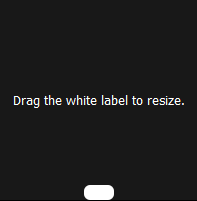 This walkthrough will create a window with a smaller label which will let you resize the window.
This walkthrough will create a window with a smaller label which will let you resize the window.
Create a new script
Script Name: Resize Window
Every snippet of code will be placed within this script.
Create a window
Create a window label which will be resizable.
--
-- Create a label that will be resized and contain the drag icon.
---
mLabel = Geyser.Label:new({
name = "mLabel",
x = 400, y = 200,
width = 200, height = 200,
fgColor = "black",
color = "blue",
message = [[<center>drag the white label to resize</center>]]
})
mLabel:setStyleSheet([[qproperty-wordWrap: true]])Create small icon inside the window
Create the label that will be used as a drag icon.
--
-- Create the small drag label within the window.
-- The y position is set to "-15px" to align it to
-- the bottom of the main label.
--
mVDrag = Geyser.Label:new({
name = "mVDrag",
x = 85, y = "-15px",
width = 30, height = 15,
fgColor = "black",
color = "white",
}, mLabel)Create callback functions
Create the callback functions that will be called by mouse and timer events.
Create a timer function that will be called repeatedly while the mouse button is pressed.
function onVDragTimer()
local x
local y
local height
-- Get mouse position
x, y = getMousePosition()
-- Substract the top of the label to get the new height.
height = y - 200
if height < MIN_HEIGHT then
-- Height is too small.
height = MIN_HEIGHT
end
-- Set the new size and restart timer.
mLabel:resize(200, height)
vdragtimer = tempTimer(0.2, onVDragTimer)
end
Create a function which will be called when we first press the icon. The function will create the timer which will trigger as long as the button is pressed.
function onVDragClick()
-- The user clicked the drag label.
-- Start a temp timer to update the size of the label.
if not exists("vdragtimer", "timer") then
vdragtimer = permTimer("vdragtimer", "", .016, "onVDragTimer()")
end
enableTimer("vdragtimer")
end
Create the callback function which will be called when we release the drag icon.
function onVDragRelease()
-- Button is release so stop timer and updates.
disableTimer("vdragtimer")
endSet up the callback functions
Set up the limit how small the window can be, and setup the callback functions.
MAX_HEIGHT = 100
--
-- Set mouse event callbacks.
--
setLabelClickCallback("mVDrag", "onVDragClick")
setLabelReleaseCallback("mVDrag", "onVDragRelease")Final result
The whole script looks like this:
--
-- Example: Resize a label.
--
-- Creates a blue label with a smaller white label, which is
-- used to resize the blue label.
--
-- Utilizing:
-- * getMousePosition()
-- * setLabelClickCallback()
-- * setLabelReleaseCallback()
-- * tempTimer().
--
--
-- Create labels
--
mLabel = Geyser.Label:new({
name = "mLabel",
x = 400, y = 200,
width = 200, height = 200,
})
mLabel:setStyleSheet([[
background-color: rgba(30, 30, 30, 80%);
qproperty-wordWrap: true;
]])
mLabel:setFontSize(10)
mLabel:echo([[<center>Drag the white label to resize.</center>]])
--
-- Create the small drag label within the window.
-- The y position is set to "-15px" to align it to
-- the bottom of the main label.
mVDrag = Geyser.Label:new({
name = "mVDrag",
x = 85, y = "-15px",
width = 30, height = 15,
fgColor = "black",
color = "white",
}, mLabel)
mVDrag:setStyleSheet([[
border-radius: 6;
background-color: white;
]])
MIN_HEIGHT = 100
--
-- Callback functions.
--
function onVDragTimer()
local x
local y
local height
-- Get mouse position
x, y = getMousePosition()
-- Substract the top of the label to get the new height.
height = y - 200
if height < MIN_HEIGHT then
-- Height is too small.
height = MIN_HEIGHT
end
-- Set the new size and restart timer.
mLabel:resize(200, height)
end
function onVDragClick()
-- The user clicked the drag label.
-- Start a temp timer to update the size of the label.
if not exists("vdragtimer", "timer") then
vdragtimer = permTimer("vdragtimer", "", .016, "onVDragTimer()")
end
enableTimer("vdragtimer")
end
function onVDragRelease()
-- Button is release so stop timer and updates.
disableTimer("vdragtimer")
end
--
-- Set mouse event callbacks.
--
setLabelClickCallback("mVDrag", "onVDragClick")
setLabelReleaseCallback("mVDrag", "onVDragRelease")